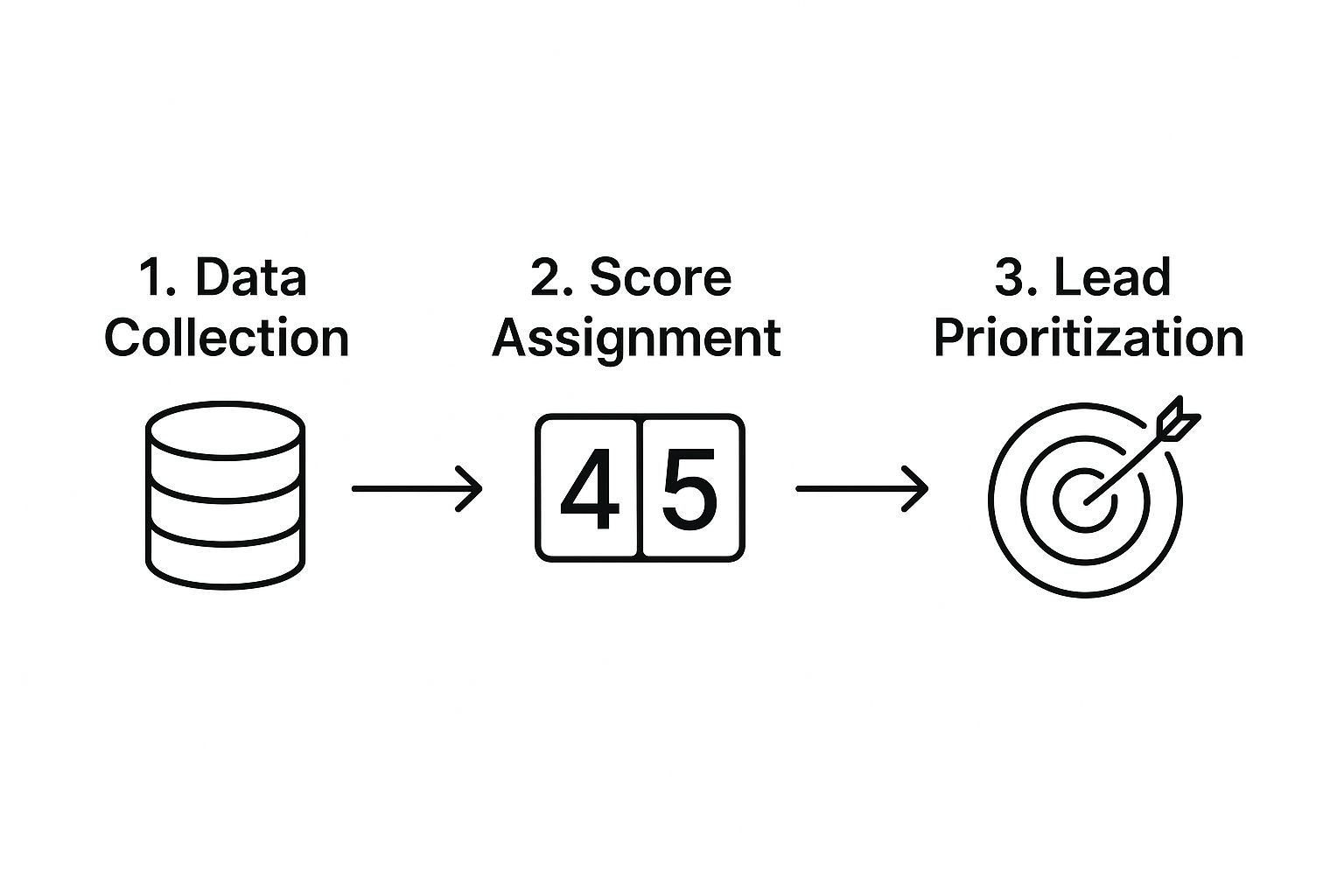Imagine your sales team having a superpower—the uncanny ability to know exactly which prospects are ready to buy and which ones are just window shopping. That's the magic of lead scoring in a nutshell. It’s a method for ranking your potential customers based on who they are and how interested they seem, separating the hot leads from the not-yet-ready crowd.

Think of lead scoring as creating a priority lane in your sales funnel. Instead of your team chasing down every single person who fills out a form, this system helps them zero in on the leads who are most likely to become paying customers. This kind of focus is a game-changer for any business, but it's especially vital for small businesses where every minute and every dollar counts.
Essentially, lead scoring is a sales and marketing strategy that assigns points to prospects. These points are based on demographic info and behavioral data, giving you a clear picture of how likely someone is to convert. This system brilliantly combines two types of information to build a complete profile of a potential customer.
Before you can score leads, you need a steady stream of them coming in. It's worth exploring some effective lead generation strategies to build a solid pool of prospects for your scoring model to work its magic on.
The whole system works by analyzing specific data points that signal a lead's quality and intent to buy. These clues generally fall into two main buckets:
By assigning points to these different attributes and actions, you end up with a clear, actionable score for every single lead.
The Bottom Line: A higher score means a "hotter" lead, which is the green light for your sales team to engage immediately. This shifts your follow-up process from a guessing game to a sharp, data-driven strategy.
A strong lead scoring model doesn't just appear out of thin air. It’s carefully built on two foundational pillars: who your leads are and what they do. Getting a handle on these components gives you a practical blueprint for separating high-potential prospects from those who are just browsing.
Think of it like building a profile. The first pillar is all about the "who"—the firmographic and demographic data. This is the explicit information you gather, the hard facts that answer the question, "Is this lead actually a good fit for my business?" We're talking about details like job title, company size, industry, and location. If your ideal customer is a construction manager at a company with over 50 employees, you'll want to give more points to any lead who fits that description.
The second pillar, which is just as important, is all about the "what"—the behavioral data. This involves tracking the digital footprints a lead leaves behind as they interact with your brand. These actions are gold because they reveal a lead's interest level and how close they might be to making a purchase. Someone who keeps coming back to your pricing page is showing a lot more intent than someone who just skims a single blog post.
You can assign different point values to various actions. For example:
This screenshot from Wikipedia perfectly illustrates how you can categorize different lead attributes and assign scores.

As you can see, it breaks scoring down into "Fit" (demographics) and "Interest" (behaviors), which is the absolute core concept of any effective model.
A critical part of a smart lead scoring system is negative scoring. Not all actions are positive signals. A prospect visiting your "Careers" page, or an existing customer looking for your support portal, should probably have points deducted. This simple step prevents false positives from cluttering your sales team's pipeline and ensures your model is as intelligent as it is powerful.
Alright, let's move from theory to practice. Getting your first lead scoring framework off the ground is a lot simpler than you might think. You don't need a data science degree—just some good old-fashioned collaboration and a clear focus on what actually moves the needle for your business. The trick is to start simple and make it better over time.
Your first, and most critical, step? Get your sales team in a room. These are the people on the front lines, and they know exactly what a great lead looks like. This isn't just a marketing task; their real-world insights are the bedrock of a model that actually works.
Together, you and the sales team need to figure out the key traits and actions that scream, "This person is ready to talk." The goal is to create two distinct lists of criteria.
Once you’ve got your lists, it’s time to assign points. A "Request a Demo" action is a huge buying signal and should be worth way more than someone who just opened a newsletter.
Key Takeaway: A collaborative approach makes sure your lead scoring model is grounded in reality. When sales helps build the system from the start, they’re far more likely to trust it and use it, which is the only way to close the loop between your marketing efforts and actual revenue.
After assigning points, you need to define what those points mean. For example, maybe any lead who hits 75 points gets tagged as a Marketing Qualified Lead (MQL). Once they cross the 100-point mark, they're automatically upgraded to a Sales Qualified Lead (SQL) and sent straight to the sales team for immediate follow-up.
This infographic breaks down the simple, three-stage process of collecting data, scoring it, and turning it into a priority list for your team.

This visual flow really highlights how raw data gets turned into an actionable game plan for your sales team.
The final step is to put it all on autopilot. Integrate these rules into your CRM or a platform like My AI Front Desk to automate the entire process. This ensures that no hot lead ever goes cold.

Putting a smart lead scoring system in place does more than just tidy up your data. It leads to real, measurable growth and a healthier bottom line. The first thing you'll notice is a huge jump in your sales team's efficiency. They stop chasing down every single lead and can pour their energy into prospects who have already shown they're interested and a good fit.
This focused strategy is a game-changer. It prevents your team from burning out and lets them have more substantial, productive conversations. When salespeople know that every lead they receive is already warmed up and qualified, their morale and performance skyrocket. Less time on dead ends means more time closing deals.
The numbers back this up. Businesses that use lead scoring have seen up to a 77% increase in lead conversion rates. They also close deals faster, shortening the average sales cycle by 27% because they aren't wasting time on people who were never going to buy.
One of the most powerful, yet often overlooked, benefits of lead scoring is its ability to finally get your sales and marketing teams rowing in the same direction. When everyone agrees on what makes a good lead, the handoff from marketing to sales becomes a smooth, transparent process. The endless debates about lead quality just disappear because everyone is playing by the same rules.
This is a cornerstone of aligning sales and marketing for B2B growth, making sure both teams are pulling together toward the same goals. This teamwork creates a predictable and reliable pipeline, which makes forecasting revenue a whole lot more accurate. By empowering your teams to focus where it counts, you don’t just boost sales—you build a stronger, more unified organization.
Let’s be honest, a lead scoring model is useless if it’s just sitting in a spreadsheet. To get real value, it has to become a living, breathing part of your day-to-day operations. That means plugging it directly into the tools you already use, especially your Customer Relationship Management (CRM) and marketing automation software.
This integration is where the magic happens. It’s what turns a good idea into a powerful engine that drives sales. When your systems are connected, they can track what leads are doing, update their scores on the fly, and automatically trigger the right next step. This is how you make your lead management both smarter and more efficient.
For instance, when a promising lead clicks over to your pricing page, that action can instantly add points to their score right inside your CRM. No manual entry, no missed details. Every single interaction helps build a clearer picture of who’s ready to talk.
The real power of hooking up your tech isn't just about tracking points—it's about creating automated workflows that act on those scores. Instead of your team having to constantly check a list, your tech stack does the heavy lifting, turning raw data into immediate, concrete actions.
Think about setting up some simple automated triggers:
By connecting your scoring model to your tech, you build a system that responds the second a prospect shows intent. This seamless flow from scoring to action is absolutely critical for shrinking your sales cycle and closing more deals. The whole point is to make sure high-value leads never, ever have to wait.
Putting together a great lead scoring model is a huge step forward. But its real value, the kind you see on the bottom line, depends on dodging a few common traps that can quietly sink the whole effort. I've seen many businesses stumble here, turning a powerful sales tool into a source of total frustration.
Knowing what these mistakes are is the best way to build a scoring program that actually works and keeps working.
One of the most common blunders is the "set it and forget it" mindset. Your market, your offerings, and your customers are always in motion. A static scoring model gets stale, fast. What signaled a "hot lead" six months ago might be a dead end today, which means your team ends up chasing ghosts while real opportunities slip by.
Another classic mistake is making the model overly complex right out of the gate. It’s tempting to want to track every little interaction, but a system with dozens of rules is a nightmare to manage, confusing for the sales team, and just begging for errors. When you're just starting, simplicity is your best friend.
This one is the real deal-breaker. If you build your lead scoring model in a marketing bubble without getting the sales team's hands dirty, you're setting it up to fail. If the people who are supposed to use the scores don't trust them, they'll just ignore them. That’s how you end up with marketing celebrating a pile of "qualified leads" that sales won't touch—and the whole point is lost.
To make sure this doesn't happen to you, you have to:
A lead scoring model isn't just a piece of marketing tech; it's a handshake agreement between sales and marketing. When sales helps write the rules, they feel ownership and trust the outcome. That’s how you get a system that drives revenue, not just reports.
In the end, avoiding these mistakes boils down to treating your lead scoring system like a living, breathing part of your business. It needs regular check-ups, open communication with sales, and a commitment to clarity. Do that, and your model will be a powerful engine for growth for years to come.
As you start to explore lead scoring, a few questions are bound to pop up. It happens to everyone. Let's tackle some of the most common ones we hear from businesses just getting started.
Think of your lead scoring model as a living part of your business, not a "set it and forget it" tool. A good rule of thumb is to review it every quarter.
Get your sales team in the room and look at the recent wins and losses. Did the lead scores actually match the outcomes? This regular check-in ensures your model stays sharp and adapts as your market—and your ideal customer—evolves.
This is a really important distinction, and getting it right is fundamental to making this whole process work.
Lead scoring is the engine that automates the journey from MQL to SQL. It creates a smooth handoff and makes sure valuable leads don't get lost in the shuffle.
Absolutely. In fact, for a small business, lead scoring might be even more critical.
When you have a smaller team and a tighter budget, you can't afford to waste time chasing down every single lead. Lead scoring helps you focus your limited resources on the opportunities most likely to turn into actual revenue. It removes the guesswork, ensuring every minute your sales team spends is a minute well spent.
Stop letting high-intent leads slip away. My AI Front Desk can instantly engage your top-scoring prospects with an AI-powered receptionist, turning interest into appointments and revenue. See how our AI solutions can supercharge your follow-up at https://myaifrontdesk.com.
Start your free trial for My AI Front Desk today, it takes minutes to setup!








